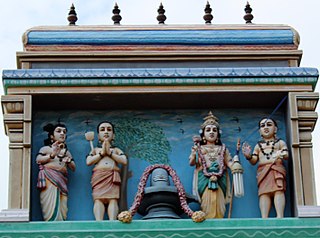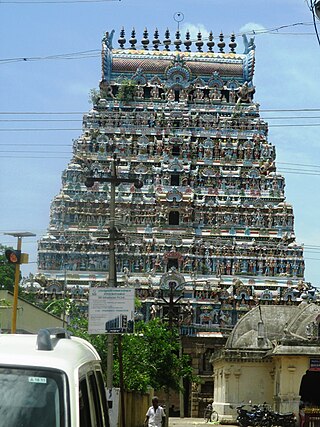
The Adikesava Perumal Temple is a Hindu temple located in Thiruvattar, Kanyakumari district, Tamil Nadu, India and is one of the 108 Divya desams, the holy sites of Hindu Vaishnavism according to existing Tamil hymns from the seventh and eighth centuries C.E. The temple is one of the historic thirteen Divya Deshams of Malai Nadu. The temple is a picturesque setting surrounded on three sides by rivers namely, It was the Rajya Temple and Bharadevatha shrine of Erstwhile Travancore. After state reorganisation, the temple handed over to Tamilnadu H&RCE Dept. The presiding Vishnu in the form of Ananthapadmabhan/Adikeshavaperumal is believed to be older than Padmanabhaswamy Temple in Thiruvananthapuram. Since Vishnu resides here in a reclining position, and is surrounded by rivers, the temple is called as "The Srirangam of Chera Kingdom".

Sundarar, also referred to as Chuntarar, Chuntaramurtti, Nampi Aruran or Tampiran Tolan, was an eighth-century poet-saint of Tamil Shaiva Siddhanta tradition of Hinduism. He is among the Tevaram trio, and one of the most prominent Nayanars, the Shaiva bhakti (devotional) poets of Tamil Nadu.

The Nellaiappar Temple is a Hindu temple dedicated to the deity Shiva, located in Tirunelveli, a city in the South Indian state of Tamil Nadu. Shiva is worshipped as Nellaiappar represented by the lingam and his consort Parvati is depicted as Kanthimathi Amman. The deity Vishnu is also worshipped here, having witnessed their wedding according to legend. Hence, this temple is regarded as an abhimana kshetram of Vaishnavism. The temple is located on the northern banks of Thamirabarani River in Tirunelveli district. The presiding deity is revered in the 7th century Tamil Saiva canonical work, the Tevaram, written by Tamil saint poets known as the nayanmars and classified as Paadal Petra Sthalam.

Arulmigu Murugan Temple, Thiruparankundram is a Hindu temple dedicated to the god Murugan at Thiruparankundram, Tamilnadu, India. It is regarded as one of the "First Houses of Murugan". The temple uses rock-cut architecture and is believed to have been built by the Pandyas during the 6th century. According to legend, Murugan slayed the demon Surapadman and married his consort Devasena at the temple. Murugan is also said to have worshipped his father Shiva at the site as Parangirinathar.

Tiruppukkozhiyur is a Hindu temple dedicated to the deity Shiva, located in Avinasi, a panchayat town in Tiruppur district in the South Indian state of Tamil Nadu. Shiva is worshipped as Avinasiappar, and is represented by the lingam. His consort Parvati is depicted as Karunambigai. The presiding deity is revered in the 7th century Tamil Saiva canonical work, the Tevaram, written by Tamil saint poets known as the Nayanars and classified as Paadal Petra Sthalam.

Mahalingeswaraswamy Temple, Thiruvidaimarudur is a Hindu temple dedicated to the deity Shiva, located in Tiruvidaimaruthur, a village in the South Indian state of Tamil Nadu. It is significant to the Hindu sect of Saivism as one of the seven major Shiva temples. Shiva is worshiped as Mahalingeswaraswamy, and is represented by the lingam, with his idol referred to as Jyothirmayalingam. His consort Mookambika is depicted as Devi Bruhatsundarakuchaambika or Bruhatsundarakuchaambigai amman. The lingam of the temple is believed to be the focal point for the seven consorts of Shiva. The presiding deity is revered in the 7th century Tamil Saiva canonical work, the Tevaram, written by Tamil poet saints known as the nayanars and classified as Paadal Petra Sthalam. The 9th century Saiva saint poet Manikkavacakar has sung praise about the temple in his works. Pattinattar, one of the revered saints visited this shrine many times.

Aiyarappar is a Hindu temple dedicated to Shiva located in the village of Tiruvaiyaru, Tamil Nadu, India. Shiva is worshiped as Aiyarappar, and is represented by the lingam and his consort Parvati is depicted as AramValarthaNaayagi. The presiding deity is revered in the 7th century Tamil Saiva canonical work, the Tevaram, written by Tamil poet saints known as the nayanars and classified as Paadal Petra Sthalam.

Sivagurunathaswamy templeis a Hindu temple dedicated to Shiva located in the village of Aduthurai, Tamil Nadu, India. Shiva is worshipped as Sivagurunathaswamy, and is represented by the lingam. His consort Parvati is depicted as Prabhavalli. The presiding deity is revered in the 7th century Tamil Saiva canonical work, the Tevaram, written by Tamil saint poets known as the nayanars and classified as Paadal Petra Sthalam.

Odhanavaneswarar Temple, Tiruchotruturai is a Hindu temple dedicated to Shiva located in the village of Tiruchotruthurai, Tamil Nadu, India. The Five Rivers are Vadavaru, Vennaaru, Vettaaru, Kudamuruttiyaaru and Kaaviriyaaru. Shiva is worshiped as Odhanavaneswarar, and is represented by the lingam and his consort Parvati is depicted as Annapoorani. The presiding deity is revered in the 7th century Tamil Saiva canonical work, the Tevaram, written by Tamil poet saints known as the nayanars and classified as Paadal Petra Sthalam.
Brahmapureeswarar Temple or Thiurkolili is a Hindu temple dedicated to Shiva located in Thirukkuvalai in Nagapattinam district of Tamil Nadu, India. Shiva is worshiped as Brahmapureeswarar, and is represented by the lingam and his consort Parvati is depicted as Vandamar Poonguzhali. The presiding deity is revered in the 7th century Tamil Saiva canonical work, the Tevaram, written by Tamil poet saints known as the nayanars and classified as Paadal Petra Sthalam.

Veerasolapuram is an ancient village located near Kallakurichi in Kallakurichi district, Tamil Nadu, India.

Amirthakadeswarar Temple is a Hindu temple dedicated to the deity Shiva, located at Sakkottai in Tamil Nadu, India. The temple is dedicated to Shiva. Shiva is worshiped as Amirthakadeswarar, and is represented by the lingam. His consort Parvati is depicted as Amirthavalli Amman. The presiding deity is revered in the 7th century Tamil Saiva canonical work, the Tevaram, written by Tamil saint poets known as the Nayanmars and classified as Paadal Petra Sthalam.
Alathur is a village in the Mannargudi taluk of Tiruvarur district in Tamil Nadu, India.

Tirunatyattankudi Rathnapureeswarar Temple is a Hindu temple located at Tirunattiyathankudi in Tiruvarur district, Tamil Nadu, India. The temple is dedicated to Shiva, as the moolavar presiding deity, in his manifestation as Rathnapureeswarar. He is also known as Manikkavannar. His consort, Parvati, is known as Mangalambikai.

Sukreesvarar Temple is a Hindu temple dedicated to the deity Shiva, located at Sarkkar Periyapalayam in Tiruppur district in Tamil Nadu, India.

Veerateeswarar Temple is a Hindu temple located at Korukkai in Mayiladuthurai district of Tamil Nadu, India. The presiding deity is Shiva in the form of Veerateswarar and his consort is known as Gnanambigai. The presiding deity is revered in the 7th century Tamil Saiva canonical work, the Tevaram, written by Tamil saint poets known as the nayanars and classified as Paadal Petra Sthalam, the 276 temples that find mention in it.
Dharmapureesvarar Temple is a Hindu temple dedicated to the deity Shiva, located at Vadakandam in Tiruvarur district, Tamil Nadu, India.
Sundaresvarar Temple is a Hindu temple dedicated to the deity Shiva, located at Vadiveesvaram in Nagercoil in Kanyakumari district, Tamil Nadu, India.
Vyagrapurisvarar Temple is a Hindu temple dedicated to the deity Shiva, located at Thaplampuliyur in the Tiruvarur district, Tamil Nadu, India.

The Punnainallur Kailasanathar Temple, is a Hindu temple dedicated to Shiva located at Punnainallur near Thanjavur in the state of Tamil Nadu, India.




















